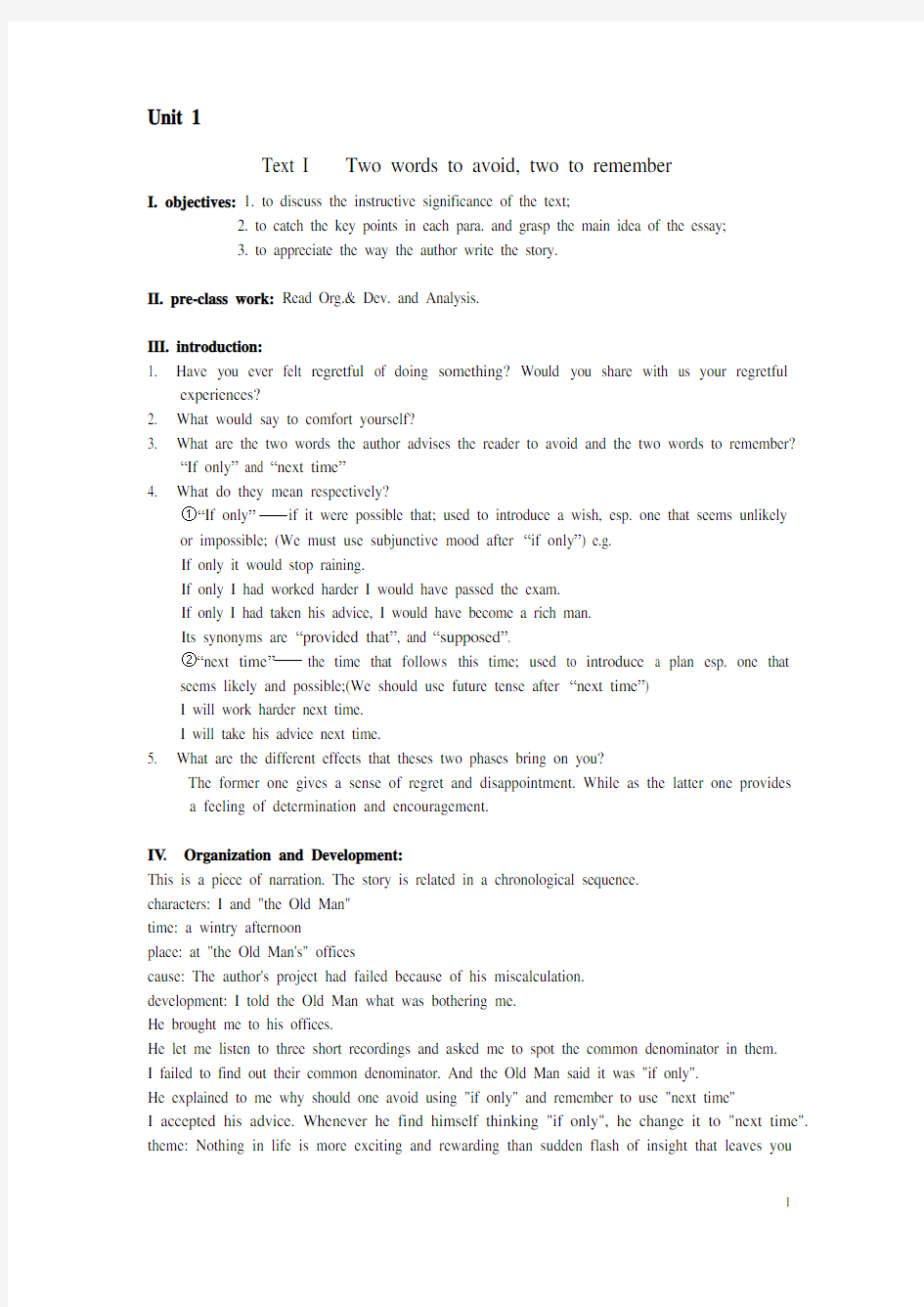新编英语教程 6 Unit 1 教案

- 1、下载文档前请自行甄别文档内容的完整性,平台不提供额外的编辑、内容补充、找答案等附加服务。
- 2、"仅部分预览"的文档,不可在线预览部分如存在完整性等问题,可反馈申请退款(可完整预览的文档不适用该条件!)。
- 3、如文档侵犯您的权益,请联系客服反馈,我们会尽快为您处理(人工客服工作时间:9:00-18:30)。
Unit 1
Text I Two words to avoid, two to remember
I. objectives: 1. to discuss the instructive significance of the text;
2. to catch the key points in each para. and grasp the main idea of the essay;
3. to appreciate the way the author write the story.
II. pre-class work: Read Org.& Dev. and Analysis.
III. introduction:
1. Have you ever felt regretful of doing something? Would you share with us your regretful
experiences?
2. What would say to comfort yourself?
3. What are the two words the author advises the reader to avoid and the two words to remember?
“If only” and “next time”
4. What do they mean respectively?
①“If only”if it were possible that; used to introduce a wish, esp. one that seems unlikely
or impossible; (We must use subjunctive mood after “if only”) e.g.
If only it would stop raining.
If only I had worked harder I would have passed the exam.
If only I had taken his advice, I would have become a rich man.
Its synonyms are “provided that”, and “supposed”.
②“next time”the time that follows this time; used to introduce a plan esp. one that
seems likely and possible;(We should use future tense after “next time”)
I will work harder next time.
I will take his advice next time.
5. What are the different effects that theses two phases bring on you?
The former one gives a sense of regret and disappointment. While as the latter one provides
a feeling of determination and encouragement.
IV. Organization and Development:
This is a piece of narration. The story is related in a chronological sequence.
characters: I and "the Old Man"
time: a wintry afternoon
place: at "the Old Man's" offices
cause: The author's project had failed because of his miscalculation.
development: I told the Old Man what was bothering me.
He brought me to his offices.
He let me listen to three short recordings and asked me to spot the common denominator in them.
I failed to find out their common denominator. And the Old Man said it was "if only".
He explained to me why should one avoid using "if only" and remember to use "next time"
I accepted his advice. Whenever he find himself thinking "if only", he change it to "next time". theme: Nothing in life is more exciting and rewarding than sudden flash of insight that leaves you
a changed person -- not only changed, but for the better.
IV. In-reading comprehension
Para.1
What is the theme of the text? How do you paraphrase the sentence?
"Nothing in life is more exciting and rewarding than sudden flash of insight
that leaves you a changed person -- not only changed, but for the better.
The most inspiring and gratifying fact of life is the unexpected spark of enlightenment that makes you
different and a better person than before.
Para.2
1. introduction about Manhattan:
Manhattan, borough of New York City, coextensive with New York County, southeastern New York, at the head of Upper New York Bay. The main economic hub of New York City, Manhattan is one of the world’s leading commercial, financial, cultural, manufacturing, medical, and tourist centers. Manhattan Island, which makes up almost all of the borough, is bounded on the north and northeast by Spuyten Duyvil Creek and the Harlem River, which separate it from the borough of the Bronx; on the east by the East River, which separates it from the boroughs of Queens and Brooklyn; on the south by Upper New York Bay; and on the west by the Hudson River, which separates it from New Jersey. The borough, about 80 sq km (about 31 sq mi) in area, also encompasses a small exclave (Marble Hill) on the Bronx mainland; several islands in the East River, including Franklin D. Roosevelt Island (the site of
a large modern housing complex), Randalls Island, and Wards Island; and Governors Island in
Upper New York Bay.
The name Manhattan is derived from an Algonquian term for “island of hills.” In 1524 the island, then inhabited by Native Americans, was probably seen by the Italian navigator Giovanni da Verrazzano.
Ethnic and social groupings characterize some residential areas of the borough. Lower Manhattan contains fairly well-defined quarters inhabited by persons of Italian, Chinese, and Hispanic descent. Also in the southern part of the borough are Greenwich Village and SoHo, districts noted for artistic and cultural activities. Battery Park City, a large-scale residential and commercial development on landfill near the tip of Manhattan Island, was constructed during the 1980s. One of the most socially select sections of Manhattan is the Upper East Side, which borders Central Park on the east and includes portions of Park and Fifth avenues. The Upper West Side, located adjacent to the western part of the park and including a portion of Riverside Dr., is another major residential area. Harlem, situated astride 125th St., contains large communities of blacks and Hispanic-Americans. Many Hispanics also live in northern Manhattan, which takes in the Washington Heights and Inwood districts.
Manhattan is one of the world’s great educational and cultural centers. Facilities of higher education in Manhattan include City College (1847) and Hunter College (1870), both part of the City University of New York; Columbia University; Cooper Union for the Advancement of Science and Art; Fordham University at Lincoln Center; the New School for Social Research (1919); New York University; Pace University (1906); Rockefeller University;
Yeshiva University; and such predominantly religious schools as Union Theological Seminary,
